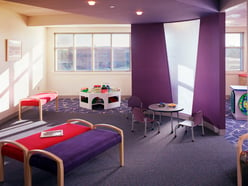A result of reform, research and technology, the healthcare industry is rapidly changing, with the common goal to improve population health. While individual choices, corporate behavior and environment influence one’s health, healthcare entities have a significant role in the management of their communities’ health. Investing in health and wellness can save money in the long run. Education and outreach enable individuals to understand the impact of personal choices. Early diagnosis and treatment, as well as chronic disease management, are less costly than treatment of advanced disease. These initiatives are augmenting the trend toward care provided in an acute care environment – in outpatient facilities today and, perhaps, with virtual visits in the future.
 As our healthcare system continues to evolve into an ambulatory-oriented and patient-centric model of care, it is becoming more common to see the development of multi-disciplinary practice sites. These care centers can create a competitive edge for healthcare organizations and can improve provider satisfaction while, most importantly, benefiting patients. Such practice sites support a team-based approach among healthcare workers of varying disciplines working side-by-side to provide specific services to patients based on their needs and a provider’s area of expertise.
As our healthcare system continues to evolve into an ambulatory-oriented and patient-centric model of care, it is becoming more common to see the development of multi-disciplinary practice sites. These care centers can create a competitive edge for healthcare organizations and can improve provider satisfaction while, most importantly, benefiting patients. Such practice sites support a team-based approach among healthcare workers of varying disciplines working side-by-side to provide specific services to patients based on their needs and a provider’s area of expertise.
Originally implemented for cancer services, we now see this model across specialties, including Digestive Health, where diagnosis and management of chronic disease, in addition to response to acute episodes requiring care, is common. The goal, however, is not to focus on digestive disease, rather on digestive health. Proactive health management is preferable to episodic, disease-based care.
Providing a one-stop experience for the patient is convenient, saves time and, most importantly, enhances communication. The patient is able to see multiple physicians, as necessary, which may include gastroenterologists, general surgeons, oncologists, endocrinologists; as well as other providers, including geneticists, dieticians, psychologists and social workers. Ideally, and schedule permitting, it is desirable to have multiple providers confer with patients and families simultaneously.
Array Architects is currently completing construction documents for a pediatric Digestive Health Center at a major, urban children’s hospital. The design team worked in conjunction with a group of physicians and practice managers, as well as hospital administrators, clinical technology, information technology and support service providers, to program, plan and design the space.
The 7,500 SF Digestive Health Center will be located in renovated space on the ninth floor of an existing hospital building that has been master-planned to house ambulatory services. The unit’s appearance will reflect the hospital's interior design standards applied to create an appealing outpatient environment for all ages, in recognition of the patient population and families’ needs. The practice site will be easily accessed from centrally located elevators. Moreover, the suite is adjacent to an existing Genetics practice, enabling direct access to it from the Digestive Health Center and enhancing Genetics provider involvement with the Digestive Health patient population.
 The team modeled the layout based on an optimal flow to allow the family to continually progress through the unit during the visit. The arrival sequence features a family waiting room and a multi-staff reception area, with a private zone for more personal conversation. A two-room triage/intake pod has dedicated sub-waiting; from here, staff will escort the family to one of the 14 standardized exam rooms. To facilitate implementation of the electronic health record, all exam rooms will be equipped with in-room, wall-mounted computers on articulating arms, located to ensure provider/patient/family eye contact and communication.
The team modeled the layout based on an optimal flow to allow the family to continually progress through the unit during the visit. The arrival sequence features a family waiting room and a multi-staff reception area, with a private zone for more personal conversation. A two-room triage/intake pod has dedicated sub-waiting; from here, staff will escort the family to one of the 14 standardized exam rooms. To facilitate implementation of the electronic health record, all exam rooms will be equipped with in-room, wall-mounted computers on articulating arms, located to ensure provider/patient/family eye contact and communication.
Additionally, the suite provides an off-stage team-documentation and communication area, two multi-purpose consultation/education rooms and one larger treatment room, with a dedicated toilet room, for motility studies. Clinicians, enthusiastic about the layout and design of this center, are looking forward to practicing as a multi-disciplinary team in support of this unique pediatric patient population.
Digestive Health also requires a diagnostic/procedural (endoscopy) component, which can be contiguous or conveniently located to the practice site. While it is ideal to have access to the procedural zone directly from the practice site, it is not always achievable. The hospital’s endoscopy suite is located on another floor of the same building. Other recent clients, such as Capital Health in Hopewell NJ, have integrated their endoscopy procedural suite into the hospital’s inpatient/outpatient interventional platform. The West Chester Gastrointestinal Group at the Jennersville Medical Office Building plans to build their procedure area as part of an impending Ambulatory Surgery Center located in the building.
In this age of rapid healthcare change, the hope is that a multi-disciplinary care approach will stimulate communication, enhance patient/family education, foster care compliance and promote wellness. Ultimately, these efforts at patient engagement in care should lead to improved outcomes, a positive experience and a reduction in costs.

